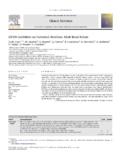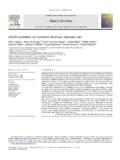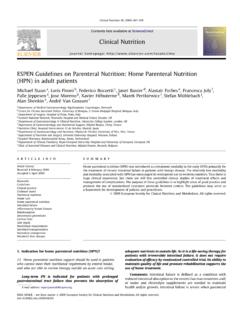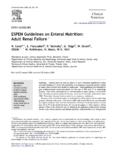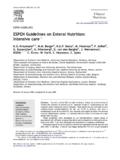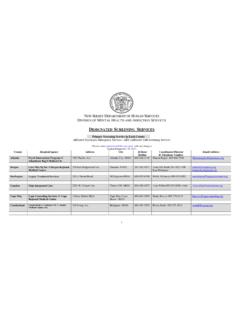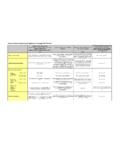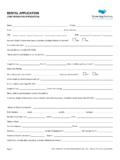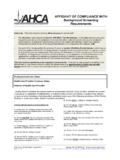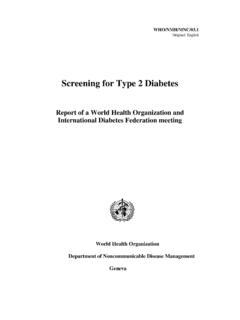Transcription of ESPENGuidelinesforNutritionScreening2002
1 Clinical Nutrition (2003) 22(4): 415 421. r 2003 Elsevier Ltd. All rights reserved. (03)00098-0. SPECIAL ARTICLE. ESPEN Guidelines for Nutrition screening 2002. J. KONDRUP,n S. P. ALLISON,y M. ELIA,z ,z M. PLAUTHy n Rigshospitalet University Hospital Copenhagen, Denmark, yQueen's Medical Centre, Nottingham, UK, zUniversity of Southampton, Southampton, UK, z University Hospital Centre,Toulouse, France, y Community Hospital Dessau, Germany (Correspondence to: JK, Nutrition Unit^5711, Rigshospitalet University, 9 Blegdamsvej, 2100 Copenhagen, Denmark). Abstract3 Aim: To provide guidelines for nutrition risk screening applicable to di erent settings (community, hospital, elderly) based on published and validated evidence available until June 2002. Note: These guidelines deliberately make reference to the year 2002 in their title to indicate that this version is based on the evidence available until 2002 and that they need to be updated and adapted to current state of knowledge in the future.
2 In order to reach this goal the Education and Clinical Practice Committee invites and welcomes all criticism and sugges- tions (button for mail to ECPC chairman). r 2003 Elsevier Ltd. All rights reserved. Key words: Nutritional Assessment; malnutrition; hos- is likely to in uence this. Outcome from treatment may pital; community be assessed in a number of ways: 1. Improvement or at least prevention of deterioration in mental and physical function Background 2. Reduced number or severity of complications of disease or its treatment. About 30% of all patients in hospital are under- 3. Accelerated recovery from disease and shortened nourished. A large part of these patients are under- convalescence. nourished when admitted to hospital and in the majority 4.
3 Reduced consumption of resources, length of of these, undernutrition develops further while in hospital stay and other prescriptions. hospital (1). This can be prevented if special attention The nutritional impairment identi ed by screening is paid to their nutritional care. Other features of the should therefore be relevant to these aims and outcomes patient's primary disease are screened routinely and and may vary according to circumstances, age or type treated ( dehydration, blood pressure, fever), and it of illness. In the community, undernutrition, with or is unacceptable that nutritional problems causing without chronic disease, may be the primary factor signi cant clinical risk are not identi ed. Neglect is also determining the mental or physical function of an beginning to have medico-legal consequences, since an individual, whereas in hospital or in a nursing home, increasing number of cases of nutritional neglect are disease factors assume a greater importance with disease- being brought to the courts.
4 There is every reason, associated undernutrition assuming an important albeit therefore, for hospitals and healthcare organizations to secondary role. screening in the community can therefore adopt a minimum set of standards in this area. be focused primarily on nutritional variables based on the However, the lack of a widely accepted screening results of semi-starvation studies such as those of Ancel system which will detect patients who might bene t Keys and his colleagues in 1950 (2). In hospitals, other clinically from nutritional support is commonly seen as aspects of disease need to be considered in combination a major limiting factor to improvement. with purely nutritional measurements in order to deter- It is the purpose of this document to give simple mine whether nutritional support is likely to be bene cial.
5 Guidelines as to how undernutrition, or risk for develop- Randomized controlled trials of nutritional support in ment of undernutrition, can be detected, by proposing a particular disease groups may therefore provide important set of standards which are practicable for general use in evidence on which to base our criteria of nutritional risk. patients and clients within present healthcare resources. Purpose of screening Methodological considerations The purpose of nutritional screening is to predict the The usefulness of screening tools can be evaluated by a probability of a better or worse outcome due to number of methods. The predictive validity is of major nutritional factors, and whether nutritional treatment importance, that the individual identi ed to be at 415.
6 416 ESPEN GUIDELINES. risk by the method is likely to obtain a health bene t appropriate care plan considering indications, from the intervention arising from the results of the possible side-effects, and, in some cases, special screening . This can be obtained in various ways, as feeding techniques. It is based, like all diagnosis, described for the individual screening tools below. The upon a full history, examination and, where screening tool must also have a high degree of appropriate, laboratory investigations. It will in- content validity, considered to include all relevant clude the evaluation or measurement of the func- components of the problem it is meant to solve. This is tional consequences of undernutrition, such as usually achieved by involving representatives of those muscle weakness, fatigue and depression.
7 It involves who are going to use it in the process of designing the consideration of drugs that the patient is taking and tool. It must additionally have a high reliability, which may be contributing to the symptoms, and of little inter-observer variation. It must also be practical, personal habits such as eating patterns and alcohol those who are going to use the tool must nd it intake. It includes gastrointestinal assessment, rapid, simple and intuitively purposeful. It should not including dentition, swallowing, bowel function, contain redundant information, information about etc. It necessitates an understanding of the inter- vomiting or dysphagia is unnecessary when dietary pretation of laboratory tests, plasma albumin intake is part of the screening .
8 The etiology of reduced which is more likely to be a measure of disease dietary intake belongs to asssessment (see below) or severity than of malnutrition per se. Calcium, is incorporated into the nutrition care plan. Several magnesium and zinc levels may be important, and other aspects of evaluating screening tools are described in some cases laboratory measurement of micro- in an analysis of 44 nutritional screening tools (3). nutrient levels may be appropriate. Finally, a screening tool should be linked to speci ed 3. Monitoring and outcome. A process of monitoring protocols for action, referral of those screened and de ning outcome should be in place. The at risk to an expert for more detailed assessment and effectiveness of the care plan should be monitored care plans.
9 By de ned measurements and observations, such as recording of dietary intake, body weight and function, and a schedule for detecting possible side- screening leads to nutritional care effects. This may lead to alterations in treatment during the natural history of the patient's condition. Hospital and healthcare organizations should have a 4. Communication. Results of screening , assessment policy and a speci c set of protocols for identifying and nutrition care plans should be communicated patients at nutritional risk, leading to appropriate to other healthcare professionals when the patient is nutritional care plans: an estimate of energy and protein transferred, either back into the community or to requirements including posssible allowance for weight another institution.
10 When patients are transferred gain, followed by prescription of food, oral supple- from the community to hospital or vice versa, it is ments, tube feeding or parenteral nutrition, or a important that the nutritional data and future care combination of these. It is suggested that the following plans be communicated. course of action be adopted. 5. Audit. If this process is carried out in a systematic 1. screening This is a rapid and simple process way, it will allow audit of outcomes which may conducted by admitting staff or community health- inform future policy decisions. care teams. All patients should be screened on admission to hospital or other institutions. The Although this document will focus mainly on the outcome of screening must be linked to de ned process of screening , this cannot be considered in courses of action: isolation and must be linked to the pathway of care a.
